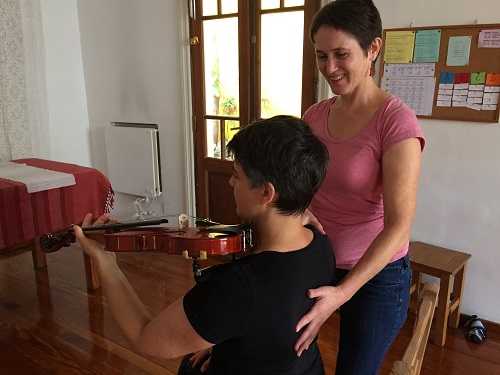Have you ever had to play an instrument or do another activity with an aching back or tense shoulders? All the musicians who came to the Alexander Technique for Strings Players the other day either had some kind of pain or injury, or had had the experience of playing in pain. I was extremely happy that all of them left with tools to change the way they use their bodies to get rid of the back or shoulder pain.
I want to share something that happened in one of my groups of musicians. There was a violinist who had a lot of pain in his body and no longer enjoyed playing so much for that reason. He played a few phrases and it was clear to me that he was making a lot of unnecessary effort that didn’t contribute to the act of playing. I asked him to play again noticing ease in his neck and paying attention to what he liked of the music as I accompanied him with my hands, using the touch communication that we use in the Alexander Technique to encourage healthy coordination of head and spine. That coordination allowed new movement, support for the instrument and soune. And he left the class feeling energized, without pain, and excited about the world of possibilities that began to open up.
Stiff muscles and muscle spasms in the back, neck and arms – all essential parts for strings players – often occur because of unconscious, excess tension. These habits of effort become part of our day-to-day lives, to the point that they seem normal to us and we don’t notice them.
F.M. Alexander’s discovery of inner coordination of the head and spine helps to free ourselves up these kinds of pains because we learn to stop doing the muscular activity that triggers it. When we use this inner coordination, the outer part coordinates itself without effort. When we consciously coordinate ourselves in this way and we give our energy a constructive direction, this has a positive and organizing effect on our whole self. It makes us feel lighter because we are no longer using effort to be upright. It allows us to get rid of tension and pressure that trigger pain, and helps us to do the things we want to do – like playing an instrument fluidly – without our backs bothering us.
If you want to learn more, you can read past articles here, subscribe to receive tips, articles and information about Alexander Technique classes, join the Mind-Body Freedom & Balance with Alexander Technique group in Facebook or write me to reserve an online class.
I am currently in Buenos Aires teaching one-on-one classes and workshops for strings players. My upcoming 3-class course is called “Exercises ‘Little Amusements’ in Alexander Technique for Strings Players.” I gave it that name because of the phrase in Italian “piccolo divertimento” that I saw in a violin book, and how that inspires me to be creative and curious instead of critical of myself!
As one violinist in a recent workshop said, using the Alexander Technique “is like being kind to yourself, because you feel lighter and freer.”
Try it out – notice ease in your neck and what it is you enjoy about what it is you’re doing. The ease may not come right away because we’re more used to finding tension and pain, but give your brain a chance to notice ease in your neck or anywhere else! Your brain and the rest of your self will appreciate it!


Recent Comments